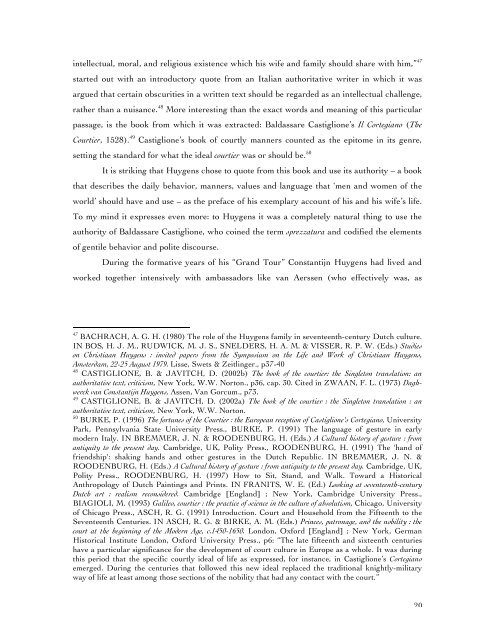Christiaan Huygens – A family affair - Proeven van Vroeger
Christiaan Huygens – A family affair - Proeven van Vroeger
Christiaan Huygens – A family affair - Proeven van Vroeger
Create successful ePaper yourself
Turn your PDF publications into a flip-book with our unique Google optimized e-Paper software.
intellectual, moral, and religious existence which his wife and <strong>family</strong> should share with him,” 47<br />
started out with an introductory quote from an Italian authoritative writer in which it was<br />
argued that certain obscurities in a written text should be regarded as an intellectual challenge,<br />
rather than a nuisance. 48 More interesting than the exact words and meaning of this particular<br />
passage, is the book from which it was extracted: Baldassare Castiglione’s Il Cortegiano (The<br />
Courtier, 1528). 49 Castiglione’s book of courtly manners counted as the epitome in its genre,<br />
setting the standard for what the ideal courtier was or should be. 50<br />
It is striking that <strong>Huygens</strong> chose to quote from this book and use its authority <strong>–</strong> a book<br />
that describes the daily behavior, manners, values and language that ‘men and women of the<br />
world’ should have and use <strong>–</strong> as the preface of his exemplary account of his and his wife’s life.<br />
To my mind it expresses even more: to <strong>Huygens</strong> it was a completely natural thing to use the<br />
authority of Baldassare Castiglione, who coined the term sprezzatura and codified the elements<br />
of gentile behavior and polite discourse.<br />
During the formative years of his “Grand Tour” Constantijn <strong>Huygens</strong> had lived and<br />
worked together intensively with ambassadors like <strong>van</strong> Aerssen (who effectively was, as<br />
47 BACHRACH, A. G. H. (1980) The role of the <strong>Huygens</strong> <strong>family</strong> in seventeenth-century Dutch culture.<br />
IN BOS, H. J. M., RUDWICK, M. J. S., SNELDERS, H. A. M. & VISSER, R. P. W. (Eds.) Studies<br />
on <strong>Christiaan</strong> <strong>Huygens</strong> : invited papers from the Symposium on the Life and Work of <strong>Christiaan</strong> <strong>Huygens</strong>,<br />
Amsterdam, 22-25 August 1979. Lisse, Swets & Zeitlinger., p37-40<br />
48 CASTIGLIONE, B. & JAVITCH, D. (2002b) The book of the courtier: the Singleton translation: an<br />
authoritative text, criticism, New York, W.W. Norton., p36, cap. 30. Cited in ZWAAN, F. L. (1973) Daghwerck<br />
<strong>van</strong> Constantijn <strong>Huygens</strong>, Assen, Van Gorcum., p73.<br />
49 CASTIGLIONE, B. & JAVITCH, D. (2002a) The book of the courtier : the Singleton translation : an<br />
authoritative text, criticism, New York, W.W. Norton.<br />
50 BURKE, P. (1996) The fortunes of the Courtier : the European reception of Castiglione's Cortegiano, University<br />
Park, Pennsyl<strong>van</strong>ia State University Press., BURKE, P. (1991) The language of gesture in early<br />
modern Italy. IN BREMMER, J. N. & ROODENBURG, H. (Eds.) A Cultural history of gesture : from<br />
antiquity to the present day. Cambridge, UK, Polity Press., ROODENBURG, H. (1991) The 'hand of<br />
friendship': shaking hands and other gestures in the Dutch Republic. IN BREMMER, J. N. &<br />
ROODENBURG, H. (Eds.) A Cultural history of gesture : from antiquity to the present day. Cambridge, UK,<br />
Polity Press., ROODENBURG, H. (1997) How to Sit, Stand, and Walk. Toward a Historical<br />
Anthropology of Dutch Paintings and Prints. IN FRANITS, W. E. (Ed.) Looking at seventeenth-century<br />
Dutch art : realism reconsidered. Cambridge [England] ; New York, Cambridge University Press.,<br />
BIAGIOLI, M. (1993) Galileo, courtier : the practice of science in the culture of absolutism, Chicago, University<br />
of Chicago Press., ASCH, R. G. (1991) Introduction. Court and Household from the Fifteenth to the<br />
Seventeenth Centuries. IN ASCH, R. G. & BIRKE, A. M. (Eds.) Princes, patronage, and the nobility : the<br />
court at the beginning of the Modern Age, c.1450-1650. London, Oxford [England] ; New York, German<br />
Historical Institute London, Oxford University Press., p6: “The late fifteenth and sixteenth centuries<br />
have a particular significance for the development of court culture in Europe as a whole. It was during<br />
this period that the specific courtly ideal of life as expressed, for instance, in Castiglione’s Cortegiano<br />
emerged. During the centuries that followed this new ideal replaced the traditional knightly-military<br />
way of life at least among those sections of the nobility that had any contact with the court.”<br />
20


